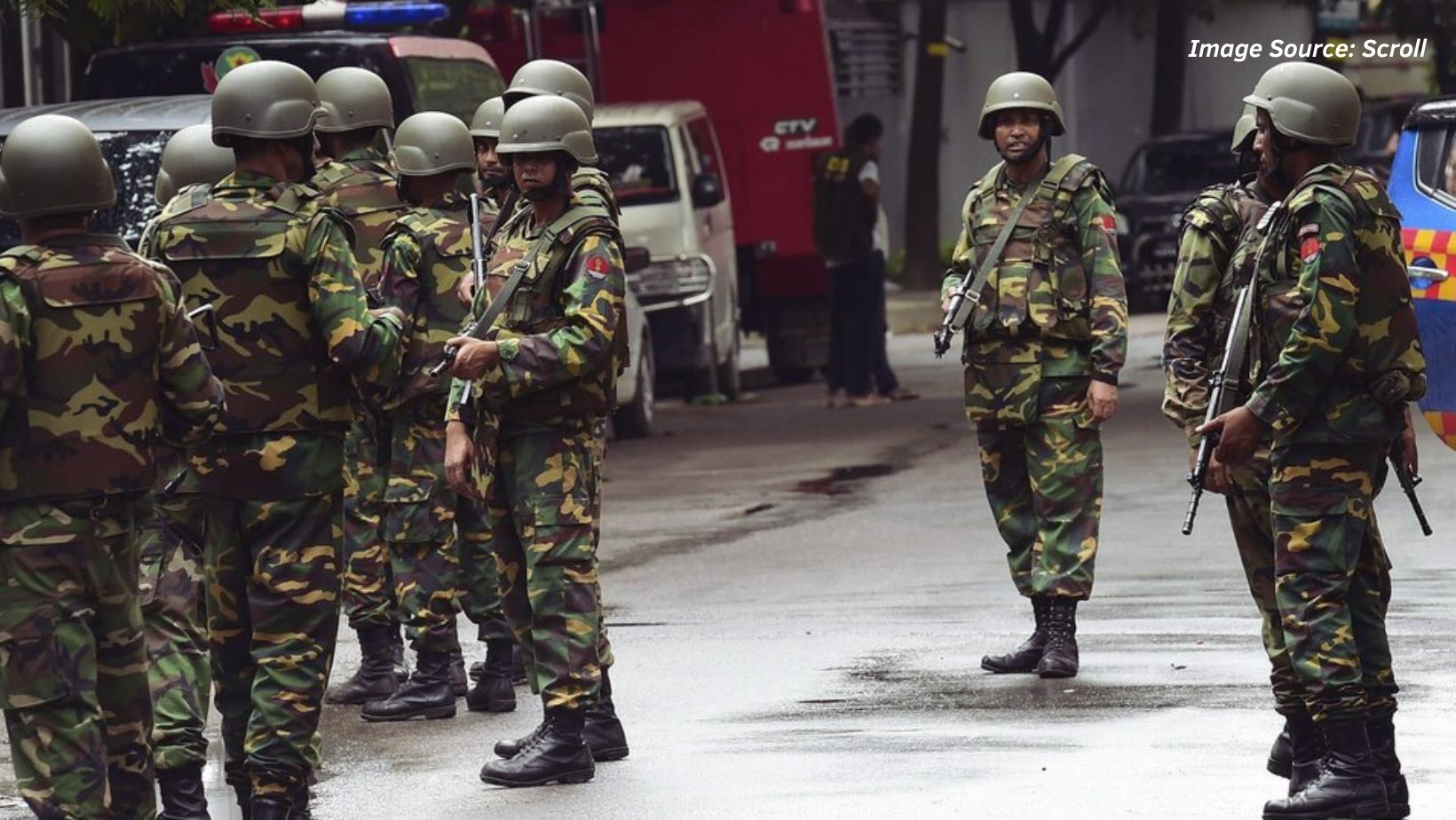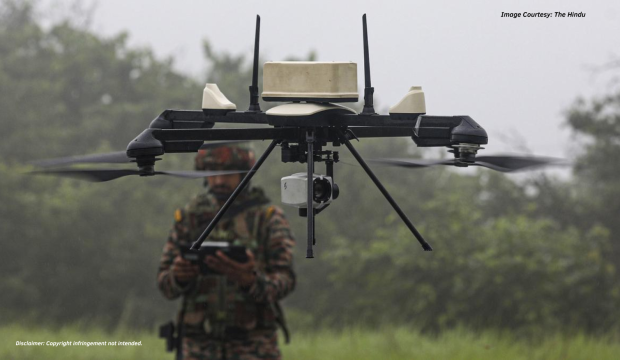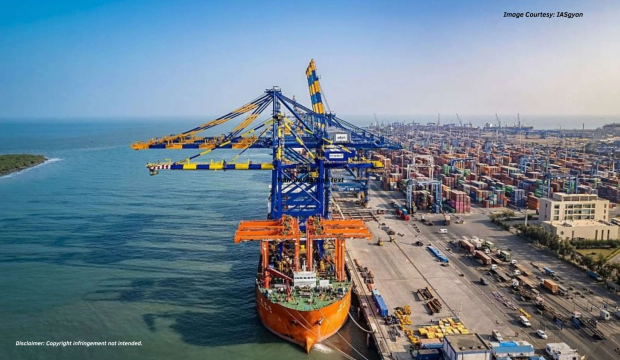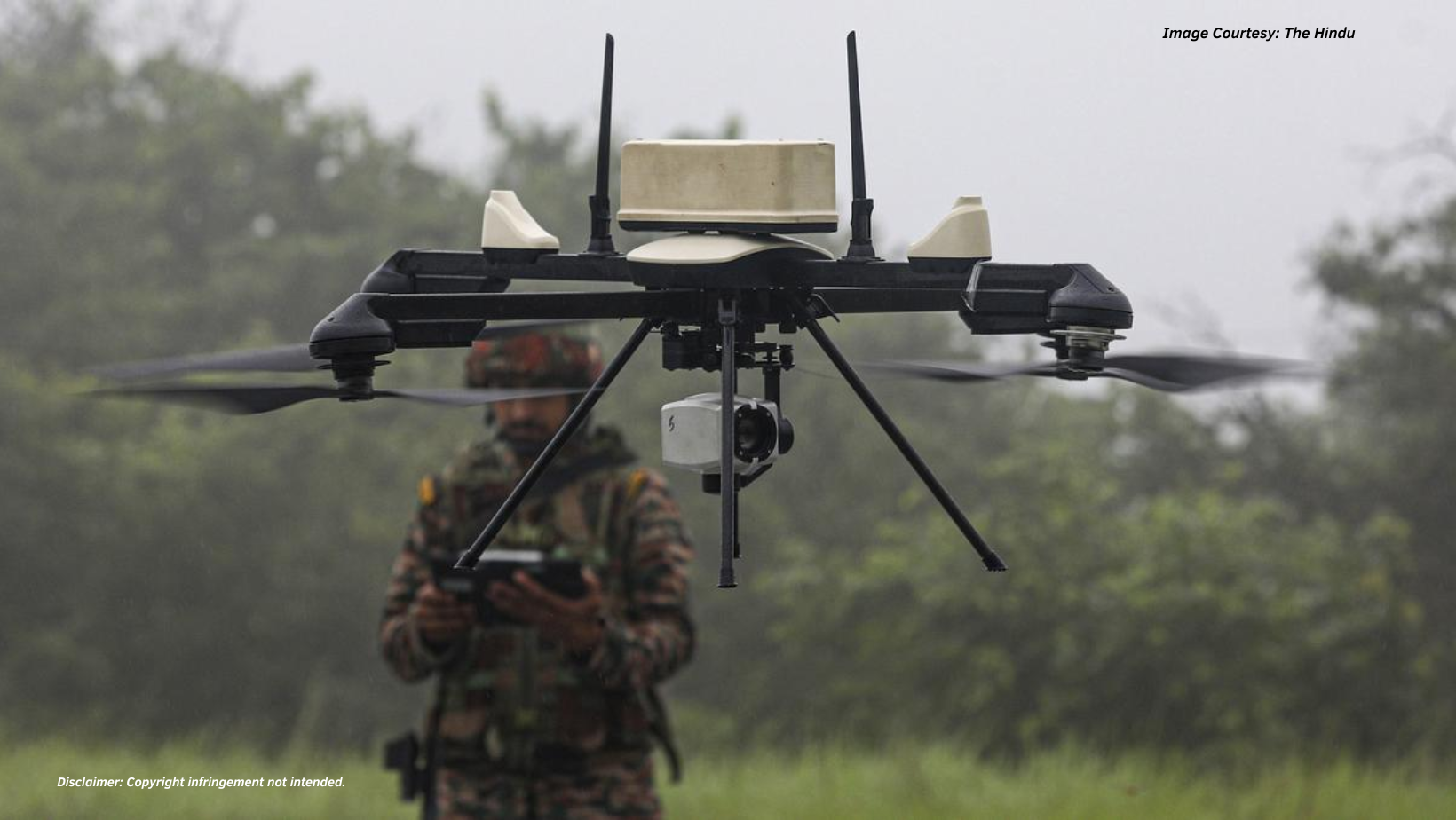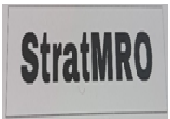Introduction
India and Bangladesh have remained linked by language and culture for a very long time, in addition to many other shared characteristics. The strong bilateral relations demonstrate a comprehensive partnership that extends well beyond a strategic alliance and is founded on equality, sovereignty, trust, and understanding. The collaboration has developed into a paradigm for bilateral ties for the whole region and beyond. Various agencies from both nations actively collaborate to combat drug trafficking, counterfeit currency, human trafficking, and other security-related issues. The 4,096 km long international border has been managed peacefully and effectively through a multitude of mechanisms, some of which include joint boundary marking, border fencing, and mutual inspection of boundary pillars, including riverine boundaries.[1] Despite the cooperation and collaborative efforts many internal security issues of Bangladesh have a spillover effect on India and the growing presence of the Inter-Services Intelligence (ISI) poses other major threats to Indian national security.
The last decade witnessed a surge in Islamic radicalisation in the neighbouring country Bangladesh. Though India played a crucial role in the country’s independence, many jihadist groups operating in the region have made it their mission to destabilise India. Aided by Pakistan, many small groups have emerged under the aegis of Jamaat-e-Islami (Bangladesh). [2]
Sheikh Hasina’s government has taken several steps to curb the emerging threat but faces a lot many challenges mainly due to the porous borders, and the political scenario. Also, there are many loopholes in the strategy to counter extremism adopted by the Bangladeshi security forces and the intelligence. This paper aims to analyse the current scenario in Bangladesh and spell out the implications for the Indian security establishment.
Background
The administration in Bangladesh has always grappled with Islamist organisations even before the liberation war in 1971. A group called Jamaat-e-Islami (JeI), fought alongside the Pakistani Army to weed out various freedom fighters as they perceived them as a hindrance in achieving the caliphate.[3]
Post the liberation, Bangladesh saw its first coup in 1975, when Ziaur Rahman took power through violence and bloodshed. During this violence, Sheikh Mujibur Rahman also known as “Bangabandhu”, was killed. Once the reins of power were seized, it was ensured that Islamization happens, and the secular values are shunned systematically. [4]
Bangladesh Nationalist Party (BNP) since the beginning has maintained deep ties with the Pakistan government and the deep state of Pakistan.[5] Many Bangladeshis have been systematically radicalised and indoctrinated with the values of radical Islam and Wahabism. Thus, many Bangladeshis have fought alongside various Islamic organisations on foreign soil such as during the Soviet-Afghan war, a large majority of fighters from various madrasas went to Afghanistan to join the fight. Upon returning, they formed various groups and factions which believed in the implementation of hardline sharia and Islamic values. These developments affected India too as the aftereffects trickled down beyond the borders.
Since 2020, Al-Qaeda Indian Subcontinent (AQIS) has stepped up its efforts to increase radicalisation in the country through the spread of propaganda materials compelling the young population to conduct lone-wolf attacks and bring “sharia” into the country. Many reports indicate that ISIS and AQIS have been using social media to spread their message since 2014 but were only able to attract close to 40 recruits to join the ranks of ISIS until the year 2016 [6] when a group of five young men conducted an attack on the Holey artisan bakery in Dhaka. This is considered the turning point in the radicalisation efforts as it drove youngsters from well-to-do families to join the jihadist groups. [7]
Another propellent that fuels the communal disharmony is the activity of local clerics, who are native to the region, have used to have authority over the interpretation of the holy Islamic texts and use it to influence the masses to achieve their personal agendas. This is another force behind radical Islam’s grip on the country. The percentage of Hindus in Bangladesh has dropped to 8% as compared to 22% in the year 1951[8]. Awami League being the only secular party in Bangladesh faces real challenges to balance between maintaining the pluralistic identity of Bangladesh and maintaining ties with the Islamic Clergy who hold a major influence among the people.
Since 2012, religious minorities have endured atrocities in Bangladesh due to misleading information spread through online posts. The general pattern is as follows: “fake news” that incites violence against minorities quickly spreads online, beginning with local community accusations that members of minority groups have vilified Islam. The use of the sentiments of the masses by a handful of politicians and religious leaders to gain ground and influence is concerning. Under the cover of darkness, unidentified individuals carried out attacks in February 2023 that resulted in the vandalism of idols at fourteen temples in three unions, or “upazilas” or “sub-districts,” in Thakurgaon.[9] In 2021, there was a significant incident where over 100 Hindu temples, festivals, stores, and residences were targeted. In addition to the seven fatalities, a Buddhist monastery in the southwest of the nation was also set on fire. The bombings also caused international news by escalating religious tensions in India. The bombings in Bangladesh were used as justification by supporters of India’s contentious citizenship act, which has been labelled as an anti-Muslim statute for granting amnesty to non-Muslim irregular immigrants from nearby nations. During the investigation by the police, it was uncovered that the unrest erupted after a Facebook post from Comilla region alleged that a Hindu Durga Puja festival site had desecrated the Quran, after the accusation was live-broadcast, rumours took off and crowds took to the streets vandalising the shops and Durga puja sites. [10]
The subsequent portion of the report will shed light on the major groups involved.
Jamaat-e-Islami–
The organisation was founded by Abu-ala-Maudidi in British India in 1941 and he remained its Amir till 1972. Jamaat began its real work in 1950 when it laid emphasis on Islam and remained committed to the unity of Pakistan. [11]
Jamaat describes itself as a moderate Islamic and believes in the idea of an Islamic state. Jamaat emerged as a major player after 1979 after the withdrawal of Political Party Regulations and is considered the best-organised outfit among all the Islam-based political parties in Bangladesh.
It became notorious in Bangladesh for collaborating with the Pakistani Army employing various influences such as[12]:
- Indoctrination through the party and other front organisations
- Madarsa education
- Targeting of women for radical activities
Jamaat’s influence in the administration and the reliance of the BNP on Jamaat for support enabled the latter to wield political and administrative authority and carry out its activities without a check.
Jamaat as part of the four-party coalition recruited a large number of sub-inspectors as militants. Intelligence agencies reported against this but due to the coalition, no action was taken as it was feared Jamaat would withdraw support and the government would fall hence the political masters turned a blind eye towards what was reported by agencies.
Harkat-ul-Jihad (HUJI-B)
The group was formed by a group of Afghan war veterans in the year 1992 [13] under the leadership of Sheikh Abdus Salam. The initial funding of the group came directly from the Osama Bin Laden-led Al-Qaeda.[14] The main aim of the group was to turn Bangladesh into a hardline Islamic state from a moderate one.
Since its existence, the group has been active not only in Bangladesh but also in India, and Nepal and recently has been fighting along the Rohingyas in Myanmar against the Burmese Army. Its links with Lashkar-e-Taiba and Jaish-e-Mohmmad have also been discovered in several other incidents and reports by intelligence agencies across the world.
The group has been responsible for attacks on the political leadership of Bangladesh including a few attacks on Sheikh Hasina herself [15]. Since the targets always belonged to the Awami Party, hence many suspect that the Bangladesh Nationalist Party and HUJI are working in tandem to achieve their goals.
HUJI has built an extensive network across Madrasas and used them as breeding grounds for the indoctrination of young minds and subsequently recruiting them for various terror activities. Through this extensive network, the group has done various medium-scale blasts in some major cities of India.
The group came under scanner and was banned in 2005.[16] Since then, it has employed different methods to disguise its activities[17]. During the four-party alliance, it formed a party under the name- “Islamic Gono Andolan”. Later they renamed it Sacheton Islami Janata in 2006. Sacheton Islami Janata taking advantage of the political instability and fragility entered an understanding with the government wherein exchange for the support, it was allowed to operate freely but it was disallowed from using armed and violent methods to achieve its religious goals. In 2008, under the caretaker government, it again underwent a transition where it remodelled itself and gave the party a more tolerant face by renaming it as “Islamic Democratic Party (IDP)”. People on the outside perceived the party to be transitioning into a more moderate Islamic organisation from a radical one but around 200-300 party members were at different levels including the apex were Afghan war veterans who had ties with the Al-Qaeda and Taliban. Thus, assuming HUJI-B has shunned the path of violence is a grave mistake. Reports by the Indian intelligence agencies also suggest that the group has close to 40 sleeper cells functioning in Assam and Nagaland.[18]
Jamaat-ul-Mujahideen Bangladesh (JMB)
The exact details regarding the origins of the group are not very clearly known but as per the widely accepted fact, it is believed that the group was formed in 1989 by Maulana Abdur Rahman. The group is active in Bangladesh and has also been active beyond borders in West Bengal with many sleeper cells. [19]
The group’s leader Abdur Rahman was educated in a madrasa where the idea of transforming Bangladesh into a hardline Islamic state got embedded in his mind. He later travelled to Pakistan and Saudi Arabia where he was introduced to Wahabi ideology. During his time in Saudi Arabia, the invasion of Afghanistan by the Soviets happened. Responding to the call to arms, he travelled to Afghanistan to train and fight alongside the Mujahids He gained extensive knowledge in the use of explosives and handling various firearms. He imparted this training to the earlier cadres which later rose to ranks and took charge of JMB as it grew and expanded.
Its links with Pakistani terror organisations were uncovered in July 2006 when two Pakistani terrorists were arrested in the Jhalakathi district in southern Bangladesh. The arrested terrorists revealed that JMB has very close ties with Lashar-e-Taiba and time again, its cadres travel to Bangladesh for training and use JMB’s resources to infiltrate into India using the Bangladesh route. [20]
In 2005, JMB carried out a series of serial blasts in 63 districts of Bangladesh due to which the Rapid Action Battalion (RAB) was tasked with hunting down the leadership of JMB. Abdur Rahman was arrested in 2006 along with six other top leaders who were hanged in March 2007.[21] During the interrogations, it came to be known that the group has a mass presence and has close to 10,000 full-time operatives with close to one lakh part-time cadres. The group was also in possession of serious arms and explosives. He also revealed that the group was active in three districts of West Bengal namely- Malda, Nadia and Murshidabad. [22]
Hizb-ut-Tahrir
The group has a presence in over 20 nations in South Asia and the Middle East. The group was established by Professor Mohiuddin Ahmed[23]. Though the group was banned in 2009 but has continued its operations through other means by using underground resources. It developed a network among various universities and the government fears that the growing base of it among the youngsters is a major concern.[24] The group also has reach among various ranks of the Bangladesh Border Guards and the Army due to which it could stage a coup against the Sheikh Hasina government in 2012 but could not succeed.[25] It was suspected that a large number of BNP leaders were also involved in the coup. The group was active in India in 2010[26] and raised its voice on many issues of atrocities being committed against Muslims all over the world and mobilised a few protests. But after the coup, the Bangladeshi government came down hard on the group, which disbanded most of its operations. Still, the group maintains a sizeable presence among the university students.
Threats to Indian National Security
As discussed in the above sections, it is quite evident that the situation in Bangladesh is grave and has several implications for the national security of India. Many Islamist groups funded by the ISI have merged in lower Assam and West Bengal.[27] After General Parvez Musharaff visited Bangladesh in 2003, ISI obtained assent to conduct its operations in Bangladesh. The extent of the relationship goes to the point where the Director General of Forces Intelligence (DGFI) of Bangladesh is colluding with the Pakistanis to cultivate new organisations and sustain the existing India Insurgent Groups (IIGs) in the Northeast.[28] The aim of the Pakistanis is simple they want to divert the Indian military’s resources away from Kashmir by keeping the northeast as a hotbed of insurgency. They have been pumping counterfeit notes to wage an economic war and disrupt the growth of the region. They have been sending fundamentalists in and out of the Indian state to upset communal harmony and keep it engaged in communal riots. It is also promoting the use of drugs among the youngsters which decreases their capabilities to contribute to economic development.
Bangladeshis’ motivation to engage in such activities is to balance India’s regional influence. It believes that India’s growing influence would lead to interference in its state affairs and would attempt to dictate the terms of various policies. Though Sheikh Hasina’s government has been very proactive in cracking down on militants and terrorists, the strategies adopted by them are centred on flushing them out of Dhaka and selecting urban centres only whereas the hills in the North of Bangladesh still serve as a base for many Indian insurgent groups and cross border terrorist organisations.
ISI with the help of Bangladeshi military and intelligence officials have been successful in turning Cox bazaar into a base for all its activities where they have established a nexus between them, terror organisations and smugglers. This has enabled them to generate funds through smuggling activities and create a black market for weapons where extremist groups can buy sophisticated weaponry.
The focus of the ISI is not only restricted to Islamist groups but also to insurgent groups such as the ULFA and NSCN-IM. There is a considerable amount of evidence which states that the top cadre of ULFA has been in contact with the Pakistani High Commission in Dhaka and has even travelled to Pakistan under fake names and Pakistani passports on several occasions.[29]
It attempted to establish a connection between these groups and groups like the Islamic Liberation Army of Assam, Muslim United Front of Assam (MULFA), and Muslim United Liberation Tigers of Assam (MULTA). As per the reports of Indian intelligence Agencies and the police, these groups started becoming active somewhere between 1994-96. [i] Since then these groups have established a considerable stronghold in the Barpeta, Nalbari, Dhubri and Goalpara districts of Assam. There have been occasions where terrorists linked to HUJI-B and HUM along with ISI agents have been arrested from Guwahati.
The existing nexus has allowed the groups to develop a robust financing system which allows it to maintain a steady cash flow throughout the year. The use of NGO(s) and madrasas as a front to gather funds along with other religious self-donation funds which also act as Hawala for many different international terrorist organisations has allowed the groups to mask their activities from the eyes of the police and agencies quite well. Another gap in the strategy of Bangladesh’s agencies is that they focus more on uprooting the overground system and have laid very little emphasis on targeting the underground system of terrorist organisations. This is particularly significant because it has been revealed that the Kuki-Chin National Front (KNF), an armed Christian group, is connected to Jama’atul Ansar Fil Hindal Sharqiya, a recently established Muslim militant organisation. Such associations also bring out the fact that though the groups might be following a hardline religious ideology but for mutual benefit, they will ally with another group that doesn’t resonate with its ideologies. The fragile nature of such alliances is usually surrounded by a cloud of mistrust and suspicion. Thus, the chances of a conflict arising and it transpiring to the level of violence and killing along with turf war is quite high.
Recommendations
India should capitalise on the friendly outlook that the current Sheikh Hasina government has towards us and work together in sync to eradicate the issue of radicalisation that plagues both nations. Some steps that can be taken in this direction include the following points-
To begin with an increase in trust between the Border Security Force- India and Bangladesh Border Guards. Both forces need to tackle the challenges of Trafficking and smuggling of humans, contraband items and weapons.
Due to the porous nature of the border and the terrain, it is difficult to man every point, therefore it becomes important to enhance the surveillance in these areas with the help of cameras equipped with motion sensors, night vision and body heat trackers. The use of drones is another method that can help the security forces monitor the border areas. Also, the riverine terrain poses a major challenge to security forces as the fences render to be useless hence it becomes even more important to ensure these areas are duly equipped with state-of-the-art surveillance equipment.
The intelligence agencies too need to collaborate, and a strong network of human intelligence needs to be developed to keep track of underground activities of the radical organisations and Muslim Fundamentalist Organisations (MFOs).
The government of India, both centre and the state governments need to emphasise on the economic development of the population living in the border regions. Bettering the overall living standards of the population will drastically reduce their susceptibility to getting indoctrinated and radicalised. Therefore, it is imperative to address the issues faced by the border populations, mitigate the hardships, and improve living standards through education and employment.
On an international level support seeking is to be done to identify various sources through which these organisations generate funds. Those sources need to be banned through the help of regulatory bodies such as the Financial Action Task Force (FATF). Though these organisations have developed means and methods to change name and disguise operations in the scenario they face sanctions and funds being frozen, mechanisms need to be developed where they are unable to undertake such activities to evade the procedures and continue operations.
Deliberations also need to be made to uproot mother organisations such as Jammat-e-Islami (Bangladesh) to ensure long-lasting peace in the region.
Conclusion
The current scenario in Bangladesh is grave. The regime has woken up against the jihadist threat after the Holey Artisan Bakery attack in 2016. Prior to it, most of the arrests and crackdowns were done in a very calculated manner to save face on the international forums and highlight Bangladesh as a key player in the fight against terrorism. Jamaat-e-Islami and BNP have colluded with the terror organisations, and intelligence agencies of both Bangladesh and Pakistan along with forming a nexus with the criminals to overthrow the Awami League government led by Sheikh Hasina.
Though the Sheikh Hasina government has taken some concrete steps to uproot terrorism from their country, but the strategy adopted by them lacks in several key areas. The operations are more centric to Dhaka and there is very little action being taken against the training camps in the Northern region of the country. Secondly, the agencies have not done much to uproot the underground system that allows the groups to recruit and fund their operations.
India has been struggling with these activities and development as many non-state actors have been taking advantage of the porous borders and with the help of the immigrant population residing in the border regions. Insurgent Groups active in the Northeast with the help of ISI have made Bangladesh their base of operations as well as many radical jihadist groups and Rohingya groups such as the Arakan Rohingya Salvation Army and HUJI-B have been using West Bengal and Assam to run their operations away from the claws of Bangladeshi security forces.
The sudden influx of immigrant population in the border regions in West Bengal, Assam, Meghalaya and Tripura has allowed the groups to recruit several sleeper agents some of which are now even functioning in other states such as Nagaland, Delhi and Maharashtra.
It has become imperative for the Indian government to weed out the agents and non-state actors working against the Indian state. It is also important to reduce the influence of ISI in Bangladesh as it is the major driving force that cultivates these groups to act against India. India needs to develop a strategy that comprises a balance of soft and hard power to dismantle the terror machinery and safeguard its interests in the Northeast.
DISCLAIMER
The paper is author’s individual scholastic articulation and does not necessarily reflect the views of CENJOWS. The author certifies that the article is original in content, unpublished and it has not been submitted for publication/ web upload elsewhere and that the facts and figures quoted are duly referenced, as needed and are believed to be correct.
Endnotes
- Review of India Bangladesh Bilateral Relations. 2024. MEA.gov.in. MEA. February 2024. https://www.mea.gov.in/Portal/ForeignRelation/Bilateral-Brief-Bangladesh-February-2024.pdf.
- Hasan, Mubashar. 2017. “South–South Migration and Security Risks: Political Islam and Violent Extremism in the Shadow of Globalisation in Bangladesh.” India Quarterly 73 (3): 312–26. https://www.jstor.org/stable/48505544.
- Abdi, S. N. M. 2023. “Bangladesh: The Wind in Jamaat-e-Islami’s Sails Is Worrying for India.” TheQuint. June 28, 2023. https://www.thequint.com/opinion/bangladesh-the-wind-in-jamaat-e-islamis-sails-is-worrying-for-india.
- Indiablooms. n.d. “The Islamization of Bangladesh by General Ziaur Rahman | Indiablooms – First Portal on Digital News Management.” Indiablooms.com. Accessed June 12, 2024. https://www.indiablooms.com/news-details/O/86195/the-islamization-of-bangladesh-by-general-ziaur-rahman.html.
Canada, Immigration and Refugee Board of. 2018. “Responses to Information Requests.” Www.irb-Cisr.gc.ca. June 5, 2018. https://www.irb-cisr.gc.ca/en/country-information/rir/Pages/index.aspx?doc=454273.
- “National Counterterrorism Center | FTOs.” n.d. Www.dni.gov. Accessed June 21, 2024. https://www.dni.gov/nctc/ftos/aqis_fto.html#:~:text=AQIS%20last%20claimed%20an%20attack%20in%202016%20in%20Bangladesh.&text=AQIS%20has%20engaged%20in%20suicide.
- Shahriar, Shamsul Huq Bin, Silvia Akter, Md. Abdul Momen, and Nayeema Sultana. 2021. “EXPATRIATION after the TERROR ATTACK: A QUALITATIVE INQUIRY from HR PERSPECTIVE.” Journal of Leadership in Organizations 3 (1). https://doi.org/10.22146/jlo.62247.
- “What’s the Future of Hindus in Bangladesh as Sheikh Hasina’s Party Woos Islamists.” 2023. India Today. December 26, 2023. https://www.indiatoday.in/world/story/bangladesh-election-hindu-population-minority-attack-population-sheikh-hasina-awami-league-bnp-2480341-2023-12-26.
- “14 Hindu Temples Vandalised in Bangladesh: Police.” n.d. NDTV.com. Accessed June 19, 2024. https://www.ndtv.com/world-news/14-hindu-temples-vandalised-in-bangladesh-police-3755949.
- Hasan, Mubashar. 2021. “Minorities under Attack in Bangladesh.” Www.lowyinstitute.org. November 18, 2021. https://www.lowyinstitute.org/the-interpreter/minorities-under-attack-bangladesh.
- Review of Jamaat-e-Islami in Bangladesh: Past, Present and Future. n.d. European Foundation for South Asian Studies. https://www.efsas.org/publications/study-papers/jamaat-e-islami-in-bangladesh-past,-present-and-future.
- The Times of India. 2023. “‘Jamaat-e-Islami Threat Not Just to Bangladesh but Entire West’: Turkish Journalist,” November 23, 2023. https://timesofindia.indiatimes.com/world/south-asia/jamaat-e-islami-threat-not-just-to-bangladesh-but-entire-west-turkish-journalist/articleshow/105437118.cms.
- “Harkat-Ul-Jihad-Al-Islami (HuJI), Extremist Group, Bangladesh, South Asia Terrorism Portal.” n.d. Satp.org. Accessed June 12, 2024. https://satp.org/satporgtp/countries/bangladesh/terroristoutfits/HUJ.HTM.
- “Country Reports on Terrorism 2016 – Foreign Terrorist Organizations: Harakat Ul-Jihad-i-Islami/Bangladesh (HUJI-B).” n.d. Refworld. Accessed June 12, 2024. https://www.refworld.org/reference/annualreport/usdos/2017/en/117878.
- “Fourteen Islamic Militants Who Attempted to Kill Bangladesh PM Hasina given Death Sentence.” n.d. The Wire. Accessed June 21, 2024. https://thewire.in/south-asia/fourteen-islamic-militants-bangladesh-pm-hasina-death-sentence.
- Bureau of Counterterrorism. 2019. “Executive Order 13224.” United States Department of State. 2019. https://www.state.gov/executive-order-13224/.
- Khan, Mohammad Jamil. 2019. “Huji Was Being Reorganised.” The Daily Star. October 3, 2019. https://www.thedailystar.net/backpage/news/huji-was-being-reorganised-1808518.
- Review of Harkat-Ul-Jihad-Al-Islami (HuJI) (Movement of Islamic Holy War). n.d. Satp.org. SATP. Accessed June 21, 2024. https://www.satp.org/satporgtp/countries/india/states/jandk/terrorist_outfits/huji.htm.
- “Kolkata Police: Indian Leader of JMB Militant Group Arrested.” 2019. Benar News. 2019. https://www.benarnews.org/english/news/bengali/indian-jmb-08262019165820.html.
- “Central Government Bans Jamaat-Ul-Mujahideen Bangladesh and Its Manifestations.” n.d. Pib.gov.in. https://pib.gov.in/Pressreleaseshare.aspx?PRID=1572568.
- “Bangladesh Marks 18th Anniversary of Series Bomb Blasts in 63 Districts.” 2023. The Business Standard. August 17, 2023. https://www.tbsnews.net/bangladesh/bangladesh-marks-18th-anniversary-series-bomb-blasts-63-districts-683726.
- “3 Jamaat Terrorists Arrested in Kolkata May Have Al-Qaeda Links: Police.” n.d. NDTV.com. Accessed June 12, 2024. https://www.ndtv.com/india-news/3-jamaat-ul-mujahideen-bangladesh-terrorists-arrested-in-kolkata-may-have-al-qaeda-links-police-2486418.
- Tipu, Sanaul Islam . 2019. Review of Court Acquits Hizb Ut-Tahrir Chief Coordinator of High Treason Charges. Dhaka Tribune . March 24, 2019. https://www.dhakatribune.com/bangladesh/court/172266/court-acquits-hizb-ut-tahrir-chief-coordinator-of.
- “Hizbut Tahrir Organizes Protests in Dhaka, Accuses Bangladeshi Government of Seeking to Normalize Relations with Israel: ‘Hasina Government Set a Milestone for Normalizing Relations with the Illegal Jewish State by Secretly Landing the U.S.-Based Israeli Aircraft on the Country’s Soil.’” n.d. MEMRI. Accessed June 12, 2024. https://www.memri.org/jttm/hizbut-tahrir-organizes-protests-dhaka-accuses-bangladeshi-government-seeking-normalize.
- “Bangladesh: An Islamist Military Coup?” n.d. Stratfor. Accessed June 12, 2024. https://worldview.stratfor.com/article/bangladesh-islamist-military-coup.
Kumar, Anand. 2012. Return from the Precipice. Pentagon Security International.
- “Fundamentalism and the ISI in Northeast Insurgency | IPCS.” n.d. Www.ipcs.org. Accessed June 21, 2024. https://www.ipcs.org/comm_select.php?articleNo=1090.
- Srivastava, Manoj . n.d. Review of Intelligence Mechanisms in Our Neighbourhood Indian Perspective. CLAWS.in. https://archive.claws.in/images/journals_doc/SW%20J.120-122.pdf.
“United Liberation Front of Asom (ULFA) – Terrorist Group of Assam.” n.d. Www.satp.org. https://www.satp.org/satporgtp/countries/india/states/assam/terrorist_outfits/ulfa.htm.
- Kumar, Anand. 2012. Return from the Precipice. Pentagon Security International
References
Kumar, Anand. 2012. Return from the Precipice. Pentagon Security International.


